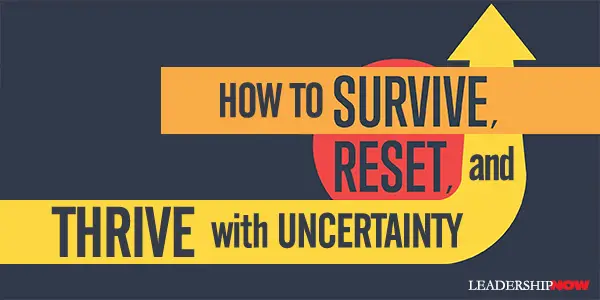 |
 |
08.30.24

How to Survive, Reset and Thrive with Uncertainty
WE can’t predict the pivotal changes still ahead, but we can learn to make good decisions to succeed with them. And not just succeed but grow. Uncertainty is neither good nor bad, depending on what we are trying to do and how we are set up. We can’t make great predictions, but we can learn to make better decisions and look for the possible upsides. We may not be able to plan for uncertainty, but we can prepare for it. To this end, Rebecca Homkes offers Survive, Reset, Thrive as a playbook to help lead successful strategies through an unprecedented range of market conditions. Survive Reset Thrive is a loop. It is an ongoing practice. As you work through the process, you may need to go back to Survive before you Thrive to restabilize. Although it is tempting to think through this linearly, no organization will experience it linearly. It is important to keep in mind that your whole organization will not likely move through it at the same time. Managing all parts of the organization in the same way will not lead to success.
Survive Homkes reminds us that Survive is a part of growth and not the opposite of it. The question becomes, how do you stabilize your organization? A basic survival question to ask is: “Based on current expenses, current linear growth rate, and cash on hand, will the company continue to profitable if the current growth rate does not increase?” If not, you are default dead. More companies are “default dead” than they realize. They are assuming third- or fourth-year bump in growth numbers as the basis for their decisions. But what happens if that assumption is challenged? What happens when a shock triggers a movement into Survive mode? Reset The power of the Survive Reset Thrive loop is in the Reset. And working with this concept is at the core of the book. Reset is the power move. Reset means change. You won’t get to thrive without a powerful reset. How do you update and change your strategy for the changing market conditions? Reset is a revisit of these six key questions that together make up your strategy story:
Thrive In Thrive an organization begins executing an adaptable strategy. Often, the hardest part is to get moving waiting for everything to be in place. Execute with agility. Agility allows you to make good decisions quickly and learn as you go. Homkes talks about learning velocity. If you learn faster, you will grow faster.Getting to Thrive takes what I call disciplined flexibility. This phrase sounds like two contradictory words thrown together, but this is true of most high growth principles. Disciplined flexibility means having a methodical approach that involves testing assumptions, verifying beliefs, and building trackers. And then when you have an insight, you must move quickly! To get to Thrive, you must combine the rigor of developing and testing insights with speed of execution. What sets thriving, high performing organizations apart comes down to five elements that she calls BLAST.

Posted by Michael McKinney at 03:03 PM
|
BUILD YOUR KNOWLEDGE
 

How to Do Your Start-Up Right STRAIGHT TALK FOR START-UPS 
Grow Your Leadership Skills NEW AND UPCOMING LEADERSHIP BOOKS 
Leadership Minute BITE-SIZE CONCEPTS YOU CAN CHEW ON 
Classic Leadership Books BOOKS TO READ BEFORE YOU LEAD |